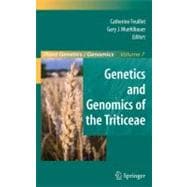
| Genetics of the Triticeae | |
| Scientific Names in the Triticeae | p. 3 |
| Triticeae Genetic Resources in ex situ Genebank Collections | p. 31 |
| Domestication of the Triticeae in the Fertile Crescent | p. 81 |
| Cytogenetic Analysis of Wheat and Rye Genomes | p. 121 |
| Applying Cytogenetics and Genomics to Wide Hybridisations in the Genus Hordeum | p. 137 |
| Methods for Genetic Analysis in the Triticeae | p. 163 |
| Genetic Mapping in the Triticeae | p. 201 |
| Early Stages of Meiosis in Wheat-and the Role of Phl | p. 237 |
| Tools, Resources and Approaches | |
| A Toolbox for Triticeae Genomics | p. 255 |
| Chromosome Genomics in the Triticeae | p. 285 |
| Physical Mapping in the Triticeae | p. 317 |
| Map-Based Cloning of Genes in Triticeae (Wheat and Barley) | p. 337 |
| Functional Validation in the Triticeae | p. 359 |
| Genomics of Transposable Elements in the Triticeae | p. 387 |
| Gene and Repetitive Sequence Annotation in the Triticeae | p. 407 |
| Brachypodium distachyon, a New Model for the Triticeae | p. 427 |
| Comparative Genomics in the Triticeae | p. 451 |
| Genetics and Genomics of Triticeae Biology | |
| Genomics of Tolerance to Abiotic Stress in the Triticeae | p. 481 |
| Genomics of Biotic Interactions in the Triticeae | p. 559 |
| Developmental and Reproductive Traits in the Triticeae | p. 591 |
| Genomics of Quality Traits | p. 611 |
| Early messages | |
| Linkage Disequilibrium and Association Mapping in the Triticeae | p. 655 |
| Triticeae Genome Structure and Evolution | p. 685 |
| Wheat and Barley Genome Sequencing | p. 713 |
| Index | p. 743 |
| Table of Contents provided by Ingram. All Rights Reserved. |
The New copy of this book will include any supplemental materials advertised. Please check the title of the book to determine if it should include any access cards, study guides, lab manuals, CDs, etc.
The Used, Rental and eBook copies of this book are not guaranteed to include any supplemental materials. Typically, only the book itself is included. This is true even if the title states it includes any access cards, study guides, lab manuals, CDs, etc.